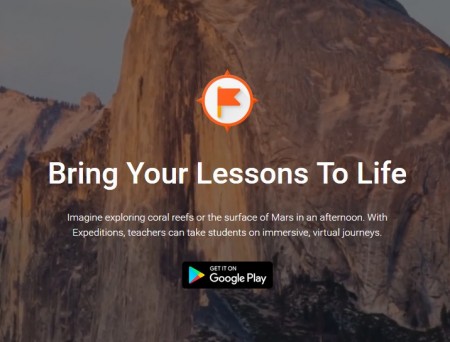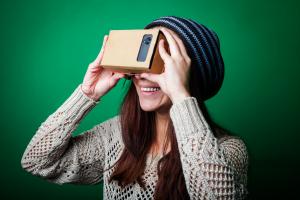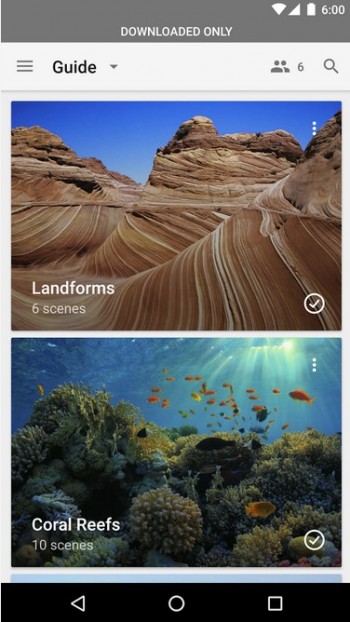July 7, 2016 – Google Expeditions is bringing virtual reality to classrooms. This Google initiative gives teachers the ability to conduct virtual trips to museums, and outer and inner space. Providing virtual reality content to existing lesson plans creates an exciting new way for young people to experience the world. Since Google launched the program in May over one million students in 11 countries have taken trips to more than 200 places.
Expeditions uses Google Cardboard (its virtual reality headset) and tablet.
A kit containing all the electronics plus the headsets can be purchased from the electronics retailer, Best Buy. Bundle prices start at $3,999 U.S. which provides a fully-outfitted kit for 10 students plus Geek Squad white glove technical service and support.
Teachers with technical chops can make up their own kits starting with the Expeditions app and purchasing Android tablets running Android 4.4 or higher and smartphones with Android 5.0 or higher. Minimal smartphone specifications include:
- Qualcomm Adreno 330 graphics processor,
- On board gyroscope, magnetometer, and accelerometer,
- 1080 high resolution display screen,
- 2 gigabytes of RAM minimally,
- wi-fi support,
- and at least 16 gigabytes of flash memory and/or a microSD slot with expansion to 32 gigabytes.
In the United Kingdom classrooms are about to gain the benefit of efforts at Open University which is conducting research into the use of Google Expeditions and virtual reality to advance the future of teaching and learning. Led by Professor Shailey Minocha the goal is to introduce the technology to schools throughout the UK as well as integrate it into Open University’s own post-secondary curriculum.
States Minocha, “Our previous research has shown that the high degree of realism now achievable in virtual field trips complement the physical field trip experience…Virtual field trips also make it possible to experience activities and locations that may be impossible, or extremely difficult, to arrange in real life.”
You got to give kudos to Google for making a major investment in 21st century learning. They have put together an online Education Training Center that includes training material for teachers to help them facilitate learning and creativity in students including the use of virtual reality. Teachers access lesson plan modules and reference resources that can be brought into the classroom. The program encourages teachers to contribute original authored material to enhance the use of Google technology for education.
If you haven’t visited the Google Education Training Center you might want to take a look, particularly if you are a teacher or parent. I checked out one of the free activities, a Google Expedition to study Coral Bleaching and Ocean Acidification aimed at Grade 12 marine biology studies. The lesson includes expedition slides illustrating the role carbon dioxide (CO2) in the ocean. Students learn about CO2 as a pollutant and as the primary source of acidifcation and principle cause of coral bleaching.
There are many free and low cost courses offered on the site. Many don’t use virtual reality and the range goes from pre-K to Grade 12. A sampling of a few of the virtual reality curriculum that is free is listed below:
- The Life of an Inventor – a tour of the Google Fab Lab aimed at Grades 9 through 12.
- World War II – a mini research project covering key war events and aimed at Grades 4 and 5.
- Explore the Coral Oceans using Google Earth aimed at Grades 5 through 11.
- Sex Around the World looking at asexual and sexual reproduction in the animal kingdom suitable for Grades 8 through 10.
What makes Google Cardboard and Expeditions an attractive option for educators? In the past virtual reality was seen as extremely expensive for classroom use. Headsets and the other gear plus training put the cost out of reach for most school boards. But Google Expedition is changing that. The viewers are cheap and most new smartphone models can work with the headset. And the BestBuy offer works out to less than $400 per student.
Other virtual reality players are not unaware of Google’s effort. Samsung has been offering free Gear virtual reality headsets with pre-orders of its latest Galaxy smartphone models. And Nearpod, a virtual reality headset developer, is offering free kits to school districts in the United States.












[…] Google Expeditions creates virtual reality experience for teachers and students taking them to places they might never be able to visit. […]
[…] to Mars to inspect the surface for life. To make this a reality, Google Cardboard launched its Pioneer Expeditions product. Under this program, thousands of schools around the world received kits containing […]